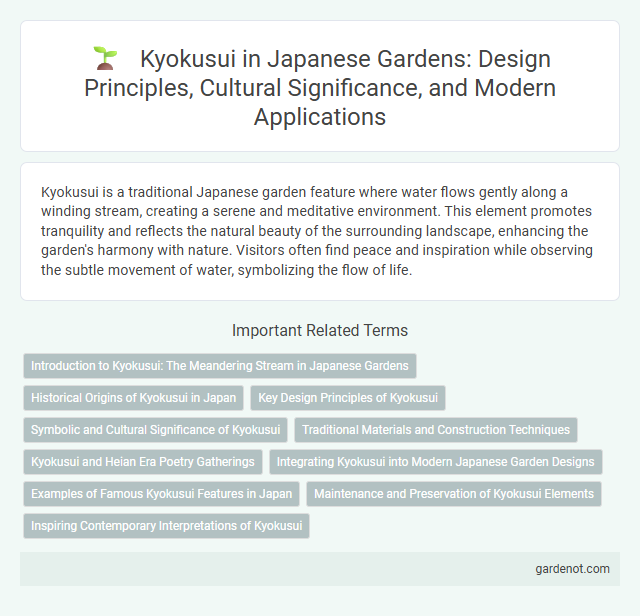Kyokusui is a traditional Japanese garden feature where water flows gently along a winding stream, creating a serene and meditative environment. This element promotes tranquility and reflects the natural beauty of the surrounding landscape, enhancing the garden's harmony with nature. Visitors often find peace and inspiration while observing the subtle movement of water, symbolizing the flow of life.
Introduction to Kyokusui: The Meandering Stream in Japanese Gardens
Kyokusui is a traditional element in Japanese gardens, characterized by a gently meandering stream that symbolizes the natural flow of water and life. This winding water feature enhances the garden's aesthetic by creating a serene atmosphere and reflecting the harmonious relationship between nature and design. Often accompanied by stepping stones or pathways, Kyokusui serves both an ornamental and contemplative purpose, inviting visitors to experience tranquility and natural beauty.
Historical Origins of Kyokusui in Japan
Kyokusui traces its historical origins to the Heian period in Japan, where aristocrats engaged in poetry composition while floating cups of sake along winding streams. This ancient practice combined nature appreciation with literary creativity, highlighting the cultural refinement of the era. The tradition reflects the deep connection between Japanese gardens and classical poetry, emphasizing harmony and aesthetic contemplation.
Key Design Principles of Kyokusui
Kyokusui design principles emphasize fluidity and harmony with nature, featuring flowing water channels that guide visual and physical movement through the garden. Natural materials like stones, wood, and carefully selected plants create a balanced composition that fosters tranquility and reflection. The layout prioritizes asymmetry and borrowed scenery (shakkei) to enhance the immersive, meditative experience inherent to Kyokusui gardens.
Symbolic and Cultural Significance of Kyokusui
Kyokusui represents the harmonious flow of nature and poetry, symbolizing purity and tranquility within Japanese garden tradition. This ancient custom involves writing poetry while floating cups of sake down a winding stream, reflecting deep cultural values of mindfulness and fleeting beauty. The ritual embodies the essence of mono no aware, capturing the transient elegance celebrated in Japanese aesthetics.
Traditional Materials and Construction Techniques
Kyokusui in Japanese gardens incorporates traditional materials such as untreated bamboo, hinoki cypress, and natural stones, emphasizing harmony with nature. Construction techniques involve skilled bamboo weaving and precise stone placement to create flowing water channels that mimic natural streams. These methods reflect centuries-old craftsmanship, preserving cultural heritage while enhancing garden aesthetics and tranquility.
Kyokusui and Heian Era Poetry Gatherings
Kyokusui, a central element of Heian Era poetry gatherings, involved nobles composing waka verses while floating cups of sake down a winding stream. This refined ritual, emblematic of Japanese garden design, reflected the Heian court's appreciation for nature, aesthetics, and literary artistry. The practice highlighted the deep connection between garden spaces and cultural expression during the Heian period.
Integrating Kyokusui into Modern Japanese Garden Designs
Kyokusui, an ancient Japanese tradition of floating cups along a winding stream for poetry composition, enriches modern Japanese garden designs by enhancing cultural depth and interactive elements. Integrating Kyokusui involves crafting gentle water channels and stone-lined paths that guide visitors through contemplative experiences while celebrating the harmony of nature and art. Contemporary landscape architects incorporate sustainable materials and minimalist aesthetics to honor Kyokusui's spiritual essence within urban green spaces.
Examples of Famous Kyokusui Features in Japan
Kyokusui, a traditional Japanese water feature known for its winding streams and poetic ambiance, is prominently showcased in gardens like Heian Shrine Garden in Kyoto, where its meandering waterway enhances the tranquility and historical atmosphere. The Shinjuku Gyoen National Garden in Tokyo also features a beautifully designed Kyokusui stream, blending natural water flow with meticulous landscaping to create a serene environment. These iconic examples highlight the cultural significance and aesthetic beauty of Kyokusui in Japanese garden design.
Maintenance and Preservation of Kyokusui Elements
Kyokusui elements in Japanese gardens require meticulous maintenance to preserve their historical authenticity and aesthetic integrity, involving regular cleaning of winding water channels and periodic reinforcement of stone pathways. Preservation efforts prioritize sustainable practices, such as using natural materials and traditional techniques that prevent erosion and maintain water purity. Careful monitoring of plant growth and seasonal adjustments ensure the harmony between Kyokusui elements and the surrounding garden landscape remains intact.
Inspiring Contemporary Interpretations of Kyokusui
Kyokusui, a traditional Japanese garden feature involving a meandering stream where poetry is composed while floating cups drift along, inspires contemporary landscape designers to blend historic elegance with modern aesthetics. Innovative interpretations emphasize integrating natural water flow, minimalistic design, and interactive experiences to evoke tranquility and cultural reflection. This fusion of ancient customs with cutting-edge techniques revitalizes Kyokusui's symbolic harmony in urban and private garden spaces worldwide.
Kyokusui Infographic

 gardenot.com
gardenot.com